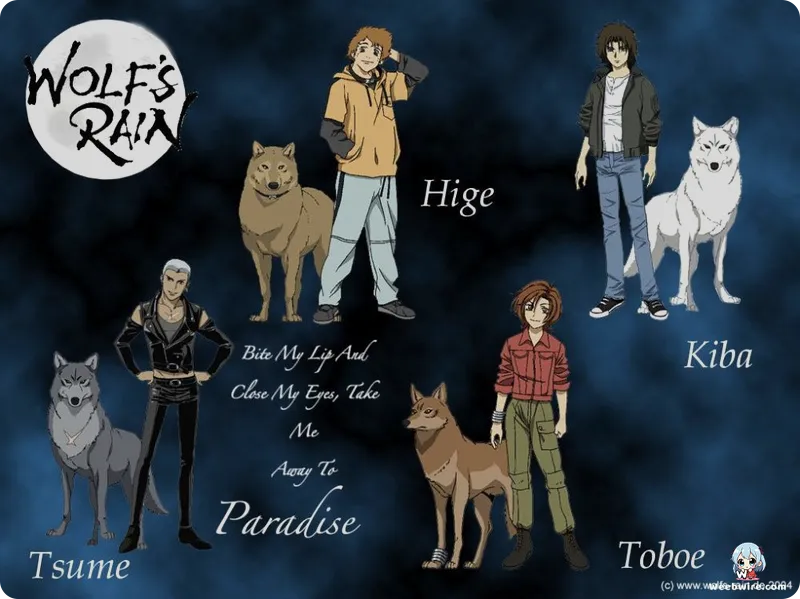Wolf's Rain: Unveiling the Profound Legacy of a Dystopian Anime Masterpiece

In the expansive tapestry of anime, few series resonate with the profound artistic and philosophical depth of Wolf's Rain. This early 2000s masterpiece continues to enthrall global audiences with its compelling blend of action, adventure, drama, fantasy, mystery, and sci-fi. More than just a survival epic, Wolf's Rain weaves a rich narrative steeped in symbolism, existential themes, and fascinating behind-the-scenes insights that elevate it far beyond a typical animated production. For both devoted fans and curious newcomers, uncovering these lesser-known facets reveals the true ingenuity underpinning this enduring cult classic.
The Genesis of an Original Vision
The genesis of Wolf's Rain is particularly captivating, rooted in the creative genius of screenwriter Keiko Nobumoto. Celebrated for her foundational contributions to Cowboy Bebop and Macross Plus, Nobumoto infused Wolf's Rain with her distinctive storytelling prowess, crafting an original concept that seamlessly marries a desolate dystopian future with ancient folklore. Her unparalleled ability to construct intricate plots while exploring profound questions about existence, destiny, and the pursuit of meaning is evident throughout the series.
Unlike numerous anime adapted from pre-existing manga or light novels, Wolf's Rain was an entirely original creation, granting Nobumoto and the creative team remarkable freedom to realize their narrative ambitions. This bold originality stands as a testament to the artistic courage of Studio BONES, a relatively nascent entity at the time, founded just a few years prior in 1998. Wolf's Rain emerged as one of BONES' early flagship projects, decisively cementing their burgeoning reputation for producing high-quality, visually stunning, and often deeply thought-provoking anime that prioritized artistic integrity above all else.
An Unforgettable Auditory Landscape
The auditory landscape of Wolf's Rain is as indelible as its visuals, largely thanks to the legendary composer Yoko Kanno. Another brilliant mind from the Cowboy Bebop dream team, Kanno's score for Wolf's Rain functions as a character in its own right, flawlessly capturing the series' melancholic beauty, desperate struggles, and fleeting glimmers of hope. From the hauntingly beautiful opening theme Stray by Steve Conte to the ethereal ending theme Gravity by Maaya Sakamoto, Kanno's eclectic range incorporating elements of rock, classical, and world music elevates every scene.
Fans frequently cite tracks like Heaven's Not Enough as prime examples of how her music transcends mere accompaniment, profoundly enhancing the emotional resonance and drawing viewers deeper into the wolves' arduous pilgrimage. The seamless synergy between Nobumoto's narrative and Kanno's unforgettable music creates an immersive experience rarely achieved in other anime.
Identity, Metaphor, and Character Design
At its core, Wolf's Rain delves into the profound concept of identity through its unique premise: wolves, long believed extinct, possess the extraordinary ability to assume human form to the untrained eye. This is not merely a clever plot device; it serves as a central thematic pillar. The wolves' relentless struggle to preserve their true forms and primal instincts in a dying world, all while navigating the complexities of human society, functions as a powerful metaphor for alienation and the inherent human quest for belonging.
Each wolf character Kiba, Tsume, Hige, and Toboe embodies distinct facets of this struggle, rendering their individual journeys as compelling as their collective pursuit of Paradise. Toshihiro Kawamoto, celebrated for his character designs in Cowboy Bebop and Blood Blockade Battlefront, masterfully crafted the distinct appearances of both the human and wolf forms, imbuing them with both animalistic grace and profound human-like expressiveness.

Rich Symbolism and a Dystopian World
The series is richly imbued with symbolism, particularly concerning the elusive Paradise and the enigmatic Flower Maiden, Cheza. Paradise is portrayed not as a simple, tangible location but rather as a mystical, almost spiritual destination that promises salvation from a decaying world. This deliberate ambiguity allows for multiple interpretations, mirroring the characters' own evolving understanding of their ultimate purpose. Cheza, born from a lunar flower, acts as a beacon of hope and a vital key to unlocking Paradise, yet her very existence also underscores the fragility of life and the delicate balance of nature. The stark dystopian setting, replete with crumbling cities and poisoned landscapes, serves as a potent warning about environmental degradation and humanity's inherent destructive tendencies.
The Controversial and Poignant Ending
Perhaps one of the most widely discussed aspects of Wolf's Rain is its controversial and poignant ending. The original television broadcast encountered significant production delays, necessitating the inclusion of four recap episodes (27-30) before the true conclusion was finally released as original video animations (OVAs). These climactic final four episodes, often referred to as the true ending, deliver a complete, albeit frequently debated, resolution to the wolves' epic journey.
The ending is notably ambiguous and melancholic, deliberately eschewing a conventionally happy resolution in favor of a cyclical narrative that powerfully reinforces themes of rebirth and the eternal struggle for hope. This bold artistic choice compelled many viewers to ponder the true meaning of Paradise and the ultimate fate of the characters, profoundly contributing to the series' lasting legacy and its esteemed reputation as a thought-provoking work.
A Timeless Classic
With its exceptional animation quality from Studio BONES, its profound and original narrative by Keiko Nobumoto, and its unforgettable soundtrack by Yoko Kanno, Wolf's Rain stands as an undisputed timeless classic. It is a series that richly rewards multiple viewings, consistently revealing new layers of meaning and symbolism with each watch. Its unwavering focus on existential themes, pressing environmental concerns, and the enduring power of hope against overwhelming odds firmly secures its place as a significant and enduring piece of anime history.
Credits
Wolf's Rain
Author
Keiko Nobumoto
Cover Art
Toshihiro Kawamoto
Studio
BONES
Publisher
Bandai Visual
Producers





